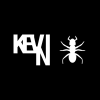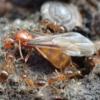Caught these a while ago.
Workers: 3-4mm with orange tip on gaster
South Jersey, couldn't get picture of the queen but if needed let me know.'



Edited by Kevin, January 29 2017 - 1:33 PM.


Best Answer MrILoveTheAnts , January 29 2017 - 3:11 PM
Either A. rudis or A. fulva. Leaning towards A. rudis because I know how common they are here.
Go to the full post
Caught these a while ago.
Workers: 3-4mm with orange tip on gaster
South Jersey, couldn't get picture of the queen but if needed let me know.'



Edited by Kevin, January 29 2017 - 1:33 PM.
Hit "Like This" if it helped.
Either A. rudis or A. fulva. Leaning towards A. rudis because I know how common they are here.
North America: Ant Genera, Species List, "Native Plants for Honeybees" | My YouTube Channel
I have 2 Apheanogaster colonies, and they are 2 different species from what I can tell. One is a bit bigger in worker size than the other. I think for this colony, Aphaenogaster rudis is correct.
Edited by Kevin, January 30 2017 - 4:36 PM.
Hit "Like This" if it helped.
It's hard to tell without seeing them. A. rudis and A. fulva are both complexes where you literally have to count the number of chromosomes in their DNA to tell them apart. You might just have a colony that's stopped making nanitics. The other option might be Aphaenogaster lamellidens, but they're roughly the same size as Formica pallidefulva workers if not slightly bigger. I find that species in fields though whereas the other two are typically in forests.
North America: Ant Genera, Species List, "Native Plants for Honeybees" | My YouTube Channel
It's hard to tell without seeing them. A. rudis and A. fulva are both complexes where you literally have to count the number of chromosomes in their DNA to tell them apart. You might just have a colony that's stopped making nanitics. The other option might be Aphaenogaster lamellidens, but they're roughly the same size as Formica pallidefulva workers if not slightly bigger. I find that species in fields though whereas the other two are typically in forests.
I see Aphaenogaster lamellidens in my woods a lot. They are a really nice redish color and pretty big compared to the other Apheanogaster. My woods is also not very dense and pretty sandy where I find this colony.
Edited by Kevin, January 30 2017 - 5:39 PM.
Hit "Like This" if it helped.
0 members, 1 guests, 0 anonymous users